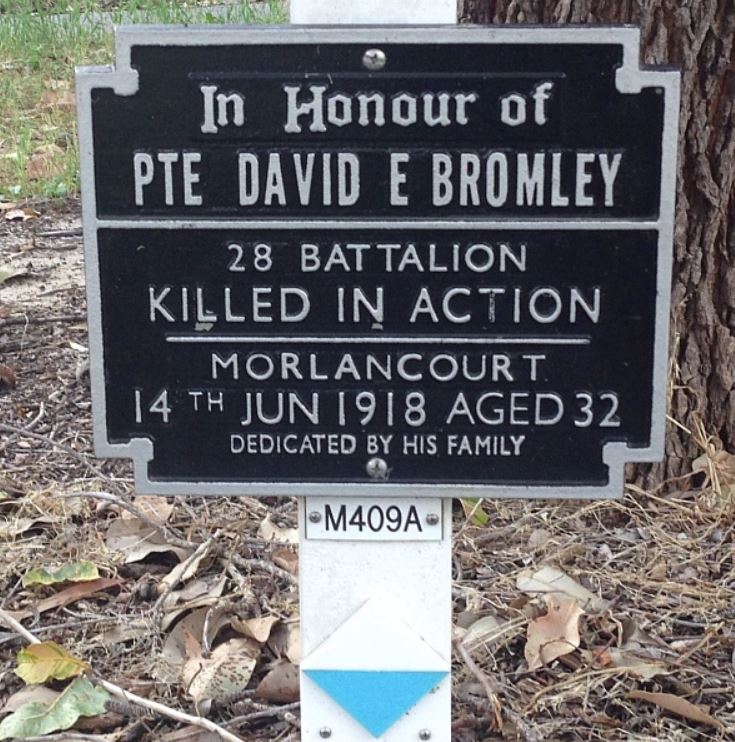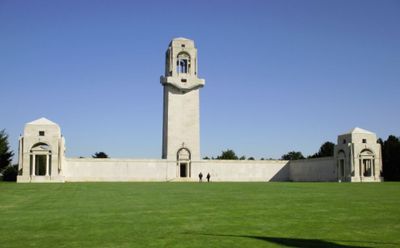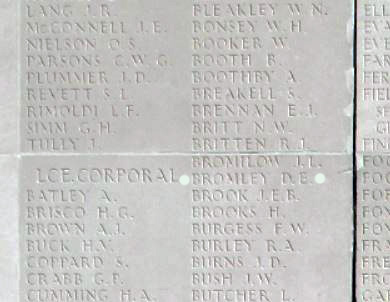Difference between revisions of "David Edward Bromley"
From Our Contribution
| (8 intermediate revisions by the same user not shown) | |||
| Line 25: | Line 25: | ||
| rank = Private | | rank = Private | ||
| unit = 28th Battalion, 13th reinforcement posted to C Company, later B Company | | unit = 28th Battalion, 13th reinforcement posted to C Company, later B Company | ||
| − | | embarkationdatefrom = | + | | embarkationdatefrom = 18 Jul 1916 |
| embarkationdateto = 9 Sep 1916 | | embarkationdateto = 9 Sep 1916 | ||
| shipembarked = [[HMAT A48 Seang Bee]] | | shipembarked = [[HMAT A48 Seang Bee]] | ||
| Line 59: | Line 59: | ||
==Pre War== | ==Pre War== | ||
| − | David was born at Yatheroo near Dandaragan in December 1885. He was the youngest of six siblings of three boys and three girls born to William | + | David was born at Yatheroo near Dandaragan in December 1885. He was the youngest of six siblings of three boys and three girls born to William and Sarah Bromley. The family emigrated from England on the ship ''Charlotte Padbury'' and David’s father worked at the Royal Perth Mint. David was the only child born in Australia and he attended school at Perth Boys. After finishing school he started work as a clerk. On 18 Oct 1913 David married Louisa Margaret Maud Winton in Perth. Louisa died on 13 Oct 1943, aged 73. She was 16 years older than David. |
==War Service== | ==War Service== | ||
| − | David entered camp on 6 Mar 1916 and on 4 Apr 1916 he was allocated to the 13th reinforcement draft for the 28th Battalion, and travelled with them to England, arriving in Plymouth on 9 Sep 1916. David and his colleagues were posted to the 7th Training Battalion at Rollestone to prepare for France. | + | David entered camp on 6 Mar 1916 and on 4 Apr 1916 he was allocated to the 13th reinforcement draft for the 28th Battalion, and travelled with them to England, arriving in Plymouth on 9 Sep 1916. David and his colleagues were posted to the [[7th Training Battalion]] at Rollestone to prepare for France. |
| − | |||
| − | David | + | David proceeded overseas to France from Folkestone on 2 Nov 1916 aboard the [[SS Princess Henriette]], and joined the [[28th Battalion]] on 18 Nov 1916. Soon after, on 4 Dec 1916 he was hospitalised with bronchitis. Seen by the 36th Casualty Clearing Station on 9 Dec 1918, he was admitted to the 10th General Hospital in Rouen from 10 -17 Dec 1916 before being released to the 2nd Convalescent Depot. |
| − | |||
| − | David | + | David rejoined the battalion on 9 Jan 1917. He was to spend another period ill in hospital with trench fever. Seen by the [[5th Field Ambulance]] on 9 Jun 1917 he was passed on to the 56th Casualty Clearing Station the same day, and then placed aboard an [[Ambulance Train]] on 18 Jun 1917 for Rouen and the 10th General Hospital where he was treated from 19 - 26 Jun 1917. From there he again spent time in the 11th Convalescent Depot before rejoining his unit on 1 Sep 1917. |
| − | |||
| − | + | The 28th Battalion was involved in the battle known as Menin Road, having moved up to the front line near Westhoek from Ypres on 18 Sep 1917. During the initial attack on 20 Sep 1917 the battalion achieved its objectives with only slight casualties, and then consolidated its position against the inevitable counter attack. Several attempts by the enemy to get into position to attack were broken up by allied artillery, as were attacks the following day. '''The names of the 'slight' number of casualties mentioned earlier cover three type written pages. Four Officers and 62 other ranks were KIA, 6 Officers and 184 other ranks were wounded, and 36 Other ranks were missing.''' David's wound was to his hand seemingly caused by a shell fragment. Seen first by the [[6th Field Ambulance]] on 20 Sep 1917, he was passed on to the 10th Casualty Clearing Station the same day, and they then placed him on an [[Ambulance Train]] for the 11th General Hospital in Camiers on the French coast, followed after treatment by a period in the 6th and 14th Convalescent Depots. On 4 Jan 1918 David had rejoined the battalion in time to enjoy a stint of leave in the UK from 1 - 18 Feb 1918. | |
| − | |||
| − | David's [https://s3-ap-southeast-2.amazonaws.com/awm-media/collection/RCDIG1035734/document/5535816.PDF Red Cross File]] contains several statements from his colleagues, but none can swear to have witnessed his death: | + | On 14 Jun 1918 he was reported to be missing after the battalion was engaged in a battle known as Third Morlancourt. This was an attack by the ''7th Australian Brigade'' (including the 28th Battalion) against the southern section of the Morlancourt spur, overlooking the village of Sailly-Laurette on the banks of the Somme River. The Australians suffered 400 casualties while taking 325 German prisoners in addition to their unknown number of German dead and wounded. When the battalion withdrew from the front line, David was reported to be missing, but on 25 Jul 1918 a Court of Enquiry felt that there was insufficient information to arrive at a finding. With no further information coming to hand, a Court of Enquiry sitting in December that year declared that he must have been Killed in Action - giving 14 Jun 1918 as the likely date. David's [https://s3-ap-southeast-2.amazonaws.com/awm-media/collection/RCDIG1035734/document/5535816.PDF Red Cross File]] contains several statements from his colleagues, but none can swear to have witnessed his death: |
| + | |||
<blockquote>"I know him well. He is a signaller in B Company, and I saw him with the Battalion at Bellicourt when I left it about a week ago, He is shortish, and round shouldered and about 25." '''5597 Pte P.T. Gallop''' | <blockquote>"I know him well. He is a signaller in B Company, and I saw him with the Battalion at Bellicourt when I left it about a week ago, He is shortish, and round shouldered and about 25." '''5597 Pte P.T. Gallop''' | ||
| Line 86: | Line 83: | ||
"On June 10th at Morlancourt our unit left the front line trench at 9:15pm. I was with Pte Bromley until we reached the enemy front line trench when Pte Bromley D.E. No 4987, was detailed by our Platoon Sergeant to escort three prisoners back to our lines. This was the last I saw of him and cannot give any information concerning Pte Bromley." '''5054 Pte Mellowship H.G''' </blockquote> | "On June 10th at Morlancourt our unit left the front line trench at 9:15pm. I was with Pte Bromley until we reached the enemy front line trench when Pte Bromley D.E. No 4987, was detailed by our Platoon Sergeant to escort three prisoners back to our lines. This was the last I saw of him and cannot give any information concerning Pte Bromley." '''5054 Pte Mellowship H.G''' </blockquote> | ||
| − | |||
| − | It appears that David was buried by the Germans as the AIF Kit Store in London forwarded a parcel received from Germany, ex the War Office of David's personal property containing 1 wallet, 1 devotional book, 1 lock of hair, and some photos. His pay book was also included, but handed to the Officer in Charge of the Estates Branch at AIF HQs. | + | Given the battle at Morlancourt occurred on 10 Jun 1918, and the 28th Battalion's War Diary for 14 Jun 1918 records no deaths, '''the date of his death may more accurately be 10 Jun 1918'''. The War Diary notes that at midnight 14/15 Jun 1918 the battalion withdrew from the front line to a rest area. It appears that David was buried by the Germans as the AIF Kit Store in London forwarded a parcel received from Germany, ex the War Office of David's personal property containing 1 wallet, 1 devotional book, 1 lock of hair, and some photos. His pay book was also included, but handed to the Officer in Charge of the Estates Branch at AIF HQs. |
<div><ul> | <div><ul> | ||
| Line 94: | Line 90: | ||
<li style="display: inline-block;"> [[File:Bromley_David_Edward_memorial.jpg|thumb|none|400px|Section of 28th Battalion panel]] </li> | <li style="display: inline-block;"> [[File:Bromley_David_Edward_memorial.jpg|thumb|none|400px|Section of 28th Battalion panel]] </li> | ||
</ul></div> | </ul></div> | ||
| − | |||
==Notes== | ==Notes== | ||
| + | For more information about the history and heritage of the City of Gosnells, please contact the Heritage Coordinator on 9391 6011 | ||
<references /> | <references /> | ||
| Line 108: | Line 104: | ||
[[Category:Clerk]] | [[Category:Clerk]] | ||
[[Category:Church of England]] | [[Category:Church of England]] | ||
| − | |||
[[Category:1918 WIA]] | [[Category:1918 WIA]] | ||
[[Category:1918 Deaths]] | [[Category:1918 Deaths]] | ||
[[Category:1918 KIA]] | [[Category:1918 KIA]] | ||
[[Category:Gosnells]] | [[Category:Gosnells]] | ||
Latest revision as of 00:28, 25 May 2023
 Kings Park Memorial walk, May drive | |
| Personal Information | |
|---|---|
| Date of Birth | c 1886 |
| Place of Birth | Yathroo, Western Australia |
| Death | 14 Jun 1918 |
| Place of Death | Morlancourt, France |
| Age at Enlistment | 30 years, 2 months |
| Description |
5'6" (1.68m) tall ; 115lbs 52.163 kg ; fresh complexion ; blue eyes ; light brown hair |
| Occupation | Clerk |
| Religion | Church of England |
| Address | 59 Bronte street, East Perth, Western Australia |
| Next of Kin | Wife , Mrs Louisa Margaret Maud Bromley |
| Military Information | |
| Reg Number | 4987 |
| Date of Enlistment | 6 Mar 1916 |
| Rank | Private |
| Unit/Formation | 28th Battalion, 13th reinforcement posted to C Company, later B Company |
| Date of Embarkation | 18 Jul 1916 ‒ 9 Sep 1916 |
| Ship Embarked On | HMAT A48 Seang Bee |
| Fate |
Wounded in action 20 Sep 1917 Menin Road Missing in action 14 Jun 1918 declared to be KIA, 3rd Morlancourt |
| Monument |
Gosnells War Memorial Gosnells Road Board Honour Roll Villers-Bretonneux Memorial Australian War Memorial |
| Medals |
British War Medal Victory Medal |
Contents
Pre War
David was born at Yatheroo near Dandaragan in December 1885. He was the youngest of six siblings of three boys and three girls born to William and Sarah Bromley. The family emigrated from England on the ship Charlotte Padbury and David’s father worked at the Royal Perth Mint. David was the only child born in Australia and he attended school at Perth Boys. After finishing school he started work as a clerk. On 18 Oct 1913 David married Louisa Margaret Maud Winton in Perth. Louisa died on 13 Oct 1943, aged 73. She was 16 years older than David.
War Service
David entered camp on 6 Mar 1916 and on 4 Apr 1916 he was allocated to the 13th reinforcement draft for the 28th Battalion, and travelled with them to England, arriving in Plymouth on 9 Sep 1916. David and his colleagues were posted to the 7th Training Battalion at Rollestone to prepare for France.
David proceeded overseas to France from Folkestone on 2 Nov 1916 aboard the SS Princess Henriette, and joined the 28th Battalion on 18 Nov 1916. Soon after, on 4 Dec 1916 he was hospitalised with bronchitis. Seen by the 36th Casualty Clearing Station on 9 Dec 1918, he was admitted to the 10th General Hospital in Rouen from 10 -17 Dec 1916 before being released to the 2nd Convalescent Depot.
David rejoined the battalion on 9 Jan 1917. He was to spend another period ill in hospital with trench fever. Seen by the 5th Field Ambulance on 9 Jun 1917 he was passed on to the 56th Casualty Clearing Station the same day, and then placed aboard an Ambulance Train on 18 Jun 1917 for Rouen and the 10th General Hospital where he was treated from 19 - 26 Jun 1917. From there he again spent time in the 11th Convalescent Depot before rejoining his unit on 1 Sep 1917.
The 28th Battalion was involved in the battle known as Menin Road, having moved up to the front line near Westhoek from Ypres on 18 Sep 1917. During the initial attack on 20 Sep 1917 the battalion achieved its objectives with only slight casualties, and then consolidated its position against the inevitable counter attack. Several attempts by the enemy to get into position to attack were broken up by allied artillery, as were attacks the following day. The names of the 'slight' number of casualties mentioned earlier cover three type written pages. Four Officers and 62 other ranks were KIA, 6 Officers and 184 other ranks were wounded, and 36 Other ranks were missing. David's wound was to his hand seemingly caused by a shell fragment. Seen first by the 6th Field Ambulance on 20 Sep 1917, he was passed on to the 10th Casualty Clearing Station the same day, and they then placed him on an Ambulance Train for the 11th General Hospital in Camiers on the French coast, followed after treatment by a period in the 6th and 14th Convalescent Depots. On 4 Jan 1918 David had rejoined the battalion in time to enjoy a stint of leave in the UK from 1 - 18 Feb 1918.
On 14 Jun 1918 he was reported to be missing after the battalion was engaged in a battle known as Third Morlancourt. This was an attack by the 7th Australian Brigade (including the 28th Battalion) against the southern section of the Morlancourt spur, overlooking the village of Sailly-Laurette on the banks of the Somme River. The Australians suffered 400 casualties while taking 325 German prisoners in addition to their unknown number of German dead and wounded. When the battalion withdrew from the front line, David was reported to be missing, but on 25 Jul 1918 a Court of Enquiry felt that there was insufficient information to arrive at a finding. With no further information coming to hand, a Court of Enquiry sitting in December that year declared that he must have been Killed in Action - giving 14 Jun 1918 as the likely date. David's Red Cross File] contains several statements from his colleagues, but none can swear to have witnessed his death:
"I know him well. He is a signaller in B Company, and I saw him with the Battalion at Bellicourt when I left it about a week ago, He is shortish, and round shouldered and about 25." 5597 Pte P.T. Gallop"On June 14 1918 at Morlancourt, Pte Bromley with Pte Mellowship went out of the trench with some German prisoners, taking them to the rear. That was the last seen or heard of Pte Bromley, but Pte Mellowship is believed to be wounded and in hospital....Informant can only say he was in the same Battalion and Company - i.e. 28.C. Not an eye-witness but heard it from pals." 5809 Pte F.S.J. Boyd
"On June 10th at Morlancourt our unit left the front line trench at 9:15pm. I was with Pte Bromley until we reached the enemy front line trench when Pte Bromley D.E. No 4987, was detailed by our Platoon Sergeant to escort three prisoners back to our lines. This was the last I saw of him and cannot give any information concerning Pte Bromley." 5054 Pte Mellowship H.G
Given the battle at Morlancourt occurred on 10 Jun 1918, and the 28th Battalion's War Diary for 14 Jun 1918 records no deaths, the date of his death may more accurately be 10 Jun 1918. The War Diary notes that at midnight 14/15 Jun 1918 the battalion withdrew from the front line to a rest area. It appears that David was buried by the Germans as the AIF Kit Store in London forwarded a parcel received from Germany, ex the War Office of David's personal property containing 1 wallet, 1 devotional book, 1 lock of hair, and some photos. His pay book was also included, but handed to the Officer in Charge of the Estates Branch at AIF HQs.
Notes
For more information about the history and heritage of the City of Gosnells, please contact the Heritage Coordinator on 9391 6011

